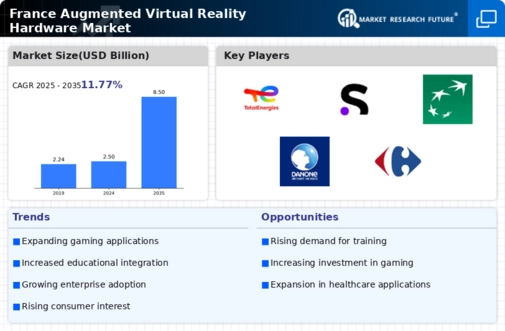Technological Advancements in Hardware
The augmented virtual-reality-hardware market is experiencing rapid technological advancements, particularly in hardware capabilities. Innovations in processing power, display resolution, and motion tracking are enhancing user experiences. For instance, the introduction of lightweight headsets with high-resolution displays is making augmented reality more accessible. In France, the market is projected to grow at a CAGR of 25% from 2025 to 2030, driven by these advancements. Companies are investing heavily in research and development to create more immersive experiences, which is likely to attract a broader audience. As hardware becomes more sophisticated, it is expected to facilitate applications across various sectors, including education and training, thereby expanding the market's reach.
Growing Demand in Retail and E-commerce
The augmented virtual-reality-hardware market is witnessing a surge in demand from the retail and e-commerce sectors. Retailers in France are increasingly adopting augmented reality solutions to enhance customer engagement and improve shopping experiences. For example, virtual fitting rooms and interactive product displays are becoming commonplace. This trend is supported by a report indicating that 70% of consumers are more likely to purchase products when they can visualize them in their environment. As a result, the market is expected to see significant growth, with projections indicating a potential increase in revenue by €1 billion by 2027. This growing demand is likely to drive further innovation in hardware, making it a key driver for the market.
Rising Consumer Awareness and Acceptance
The augmented virtual-reality-hardware market is experiencing a rise in consumer awareness and acceptance, which is crucial for its growth. As more individuals become familiar with augmented reality technologies through various applications, their willingness to invest in hardware increases. Surveys indicate that approximately 60% of French consumers are open to purchasing augmented reality devices for personal use. This growing acceptance is likely to encourage manufacturers to develop more user-friendly and affordable products, thereby expanding the market. Additionally, as augmented reality becomes integrated into everyday life, the potential for widespread adoption appears promising. This shift in consumer perception is expected to be a significant driver for the market in the coming years.
Increased Investment in Gaming Technologies
The augmented virtual-reality-hardware market is benefiting from increased investment in gaming technologies. The gaming industry in France is rapidly evolving, with a notable shift towards immersive experiences. Major gaming companies are allocating substantial budgets to develop augmented reality games that require advanced hardware. This trend is reflected in the market, where the revenue from gaming-related hardware is expected to account for over 40% of total sales by 2026. The rise of competitive gaming and e-sports is also contributing to this growth, as gamers seek high-performance hardware to enhance their gameplay. Consequently, the influx of investment is likely to propel the market forward, creating new opportunities for hardware manufacturers.
Expansion of Training and Simulation Applications
The augmented virtual-reality-hardware market is increasingly being utilized for training and simulation applications across various industries. In sectors such as aviation, healthcare, and manufacturing, organizations in France are adopting augmented reality solutions to provide realistic training environments. This trend is supported by studies indicating that training programs utilizing augmented reality can improve retention rates by up to 75%. As companies recognize the benefits of immersive training experiences, the demand for specialized hardware is expected to rise. The market for training-related hardware is projected to grow significantly, potentially reaching €500 million by 2028. This expansion is likely to drive innovation and competition among hardware providers.
















Leave a Comment